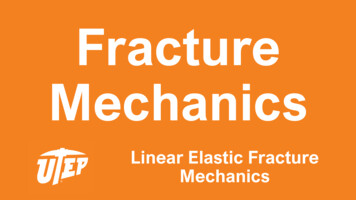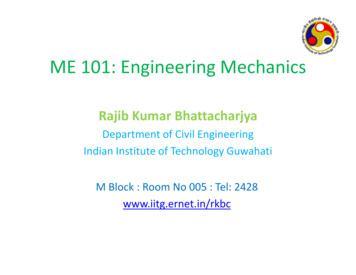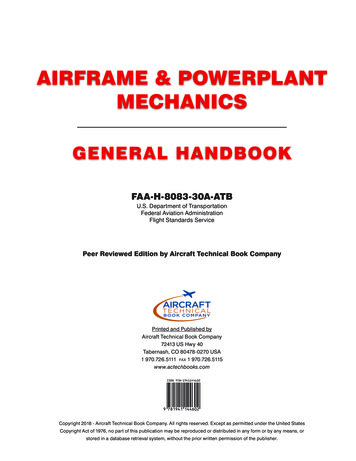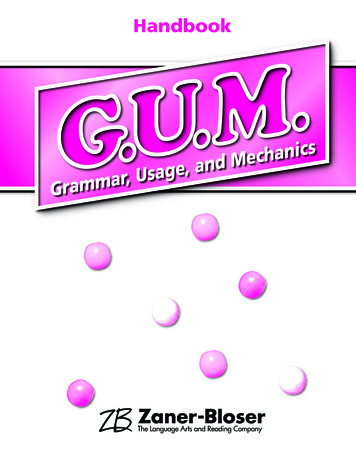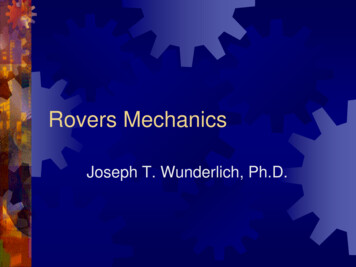
Transcription
Rovers MechanicsJoseph T. Wunderlich, Ph.D.
“Lunar Roving Vehicle”(LRV)Image from: anical Design
Lunar RoverMoon has only 1/6 of Earth’s gravity,and therefore differentSTABILITY (static and dynamic),MANEUVERABILITY,CONTROLLABILITYMechanical Design1960’s and 1970’sBENDIX CORPORATIONJ Wunderlich’s Fatherworked here (onsuspension systems )Images from: Young, A.H. Lunar and planetary rovers: the wheels of Apollo and the quest for mars, Springer; 1 edition, August 1, 2006.
Lunar RoverMechanical DesignOnly0.25 HP !sinceMoon’sgravity isonly 1/6 ofEarth’sImage from: Young, A.H. Lunar and planetary rovers: the wheels of Apollo and the quest for mars, Springer; 1 edition, August 1, 2006.
Lunar RoverMechanical DesignAstronauts needed tobecome accustomed todriving and working in 1/6of Earth’s gravityAirplane diving from highaltitudes simulatedreduced gravityImage from: Young, A.H. Lunar and planetary rovers: the wheels of Apollo and the quest for mars, Springer; 1 edition, August 1, 2006.
Lunar RoverMechanical DesignEach motorindependentlydrivenImage from: Young, A.H. Lunar and planetary rovers: the wheels of Apollo and the quest for mars, Springer; 1 edition, August 1, 2006.
Lunar RoverMechanical DesignBulkypressurizedspace suitesneed to beconsidered invehicle designImage from: Young, A.H. Lunar and planetary rovers: the wheels of Apollo and the quest for mars, Springer; 1 edition, August 1, 2006.
“Lunar Roving Vehicle” (LRV)Mechanical Design19711/6 Earth’s gravity significantly effectsmaneuverability and controllabilityImage from: Young, A.H. Lunar and planetary rovers: the wheels of Apollo and the quest for mars, Springer; 1 edition, August 1, 2006.
Lunar RoverMechanical -than-a-four-wheeled-vehicle-of-theImage from: Young, A.H. Lunar and planetary rovers: the wheels of Apollo andsamethe quest for mars, Springer; 1 edition, August 1, 2006.
Lunar RoverMechanical call article.php?sid 1663&ref https%3A%2F%2Fwww.google.comImage from: Young, A.H. Lunar andplanetary rovers: the wheelsof Apollo and the quest formars, Springer; 1 edition,August 1, 2006.SOURCE: Boeing Company and NASA (1971) LRV operations handbook. appendix A performance data. Document LS006-002-2H.
Lunar RoverMechanical DesignSTATIC and DYNAMIC STABILITYC.G. CenterofGravitySOURCE: Boeing Company and NASA (1971) LRV operations handbook. appendix A performance data. Document LS006-002-2H.
Lunar RoverMechanical DesignSTATIC STABILITY“Normal” force “N”frictionforce “f” Image from: Young, A.H. Lunar and planetaryrovers: the wheels of Apollo and thequest for mars, Springer; 1 edition,August 1, 2006.frictionforce “f”SOURCE: html“Normal”force net/mechanics/circular%20motion/banked with friction.htm
Lunar RoverSTATIC STABILITYMechanical -suspension-tuningSOURCE: Boeing Company and NASA (1971) LRV operations handbook. appendix A performance data. Document LS006-002-2H.
Lunar RoverDYNAMIC STABILITYMechanical DesignTESTINGImage from: Young, A.H. Lunar and planetaryrovers: the wheels of Apollo and thequest for mars, Springer; 1 edition,August 1, 2006.SOURCE: Boeing Company and NASA (1971) LRV operations handbook. appendix A performance data. Document LS006-002-2H.
Lunar RoverDYNAMIC STABILITYMechanical DesignTESTINGSOURCE: Boeing Company and NASA (1971) LRV operations handbook. appendix A performance data. Document LS006-002-2H.
Lunar RoverDYNAMIC STABILITYMechanical DesignTESTINGSOURCE: Boeing Company and NASA (1971) LRV operations handbook. appendix A performance data. Document LS006-002-2H.
Lunar RoverDYNAMIC STABILITYMechanical DesignTESTINGSOURCE: Boeing Company and NASA (1971) LRV operations handbook. appendix A performance data. Document LS006-002-2H.
Lunar RoverDYNAMIC STABILITYMechanical DesignTESTINGSOURCE: Boeing Company and NASA (1971) LRV operations handbook. appendix A performance data. Document LS006-002-2H.
Lunar RoverDYNAMIC STABILITYMechanical DesignTESTINGSOURCE: Boeing Company and NASA (1971) LRV operations handbook. appendix A performance data. Document LS006-002-2H.
Lunar RoverDYNAMIC STABILITYMechanical DesignTESTINGSOURCE: Boeing Company and NASA (1971) LRV operations handbook. appendix A performance data. Document LS006-002-2H.
Lunar RoverDYNAMIC STABILITYMechanical DesignTESTINGSOURCE: Boeing Company and NASA (1971) LRV operations handbook. appendix A performance data. Document LS006-002-2H.
Lunar RoverDYNAMIC STABILITYMechanical DesignTESTINGSOURCE: Boeing Company and NASA (1971) LRV operations handbook. appendix A performance data. Document LS006-002-2H.
Lunar RoverDYNAMIC STABILITYMechanical DesignTESTINGSOURCE: Boeing Company and NASA (1971) LRV operations handbook. appendix A performance data. Document LS006-002-2H.
Lunar RoverDYNAMIC STABILITYMechanical DesignTESTINGSOURCE: Boeing Company and NASA (1971) LRV operations handbook. appendix A performance data. Document LS006-002-2H.
Lunar RoverDYNAMIC STABILITYMechanical DesignTESTINGSOURCE: Boeing Company and NASA (1971) LRV operations handbook. appendix A performance data. Document LS006-002-2H.
Lunar RoverCONTROLLABILITYMechanical DesignTESTINGSOURCE: Boeing Company and NASA (1971) LRV operations handbook. appendix A performance data. Document LS006-002-2H.
Lunar RoverCONTROLLABILITYMechanical DesignTESTINGSOURCE: Boeing Company and NASA (1971) LRV operations handbook. appendix A performance data. Document LS006-002-2H.
Lunar RoverCONTROLLABILITY and MANEUVERABILITYMechanical DesignTESTINGSOURCE: Boeing Company and NASA (1971) LRV operations handbook. appendix A performance data. Document LS006-002-2H.
Lunar RoverCONTROLLABILITY and MANEUVERABILITYMechanical DesignTESTINGSOURCE: Boeing Company and NASA (1971) LRV operations handbook. appendix A performance data. Document LS006-002-2H.
Lunar RoverCONTROLLABILITY and MANEUVERABILITYMechanical DesignTESTINGSOURCE: Boeing Company and NASA (1971) LRV operations handbook. appendix A performance data. Document LS006-002-2H.
Lunar RoverCONTROLLABILITY and MANEUVERABILITYMechanical DesignTESTINGSOURCE: Boeing Company and NASA (1971) LRV operations handbook. appendix A performance data. Document LS006-002-2H.
Wheel Configurations for Rolling VehiclesSOURCE: R. Siegwart and I. Nourbakhsh, Autonomous mobile robots, Massachusetts Institute of Technology,2004.
Wheel Configurations for Rolling VehiclesSOURCE: R. Siegwart and I. Nourbakhsh, Autonomous mobilerobots, Massachusetts Institute of Technology, 2004.Humanoid Robot riding a bike VIDEO:https://www.youtube.com/watch?v mT3vfSQePcs
Wheel Configurations for Rolling VehiclesSOURCE: R. Siegwart and I. Nourbakhsh, Autonomous mobile robots, Massachusetts Institute of Technology, 2004.
Wheel Configurations for Rolling VehiclesSOURCE: R. Siegwart and I. Nourbakhsh, Autonomous mobile robots, Massachusetts Institute of Technology, 2004.
SOURCE: R. Siegwart and I. Nourbakhsh, Autonomous mobile robots, Massachusetts Institute of Technology, 2004.
Wheel Configurations for Rolling VehiclesSOURCE: R. Siegwart and I. Nourbakhsh, Autonomous mobile robots, Massachusetts Institute of Technology, 2004.
Wheel Configurations for Rolling VehiclesSOURCE: R. Siegwart and I. Nourbakhsh, Autonomous mobile robots, Massachusetts Institute ofTechnology, 2004.NOTE: A tank is similar to above in its steering by moving treads indifferent directions, but the circles shown above are merelyanalogous to the ends of the treads supporting the vehicle for stability
Rolling VehiclesTANKSU.S. M1A1,M1A2, M1A3VIDEO: https://www.youtube.com/watch?v t1oXoHUqlNgRussian Video comparing M1A1 to Russian T-90VIDEO: https://www.youtube.com/watch?v n3cdXJX6i8Q(read all comments below video in YouTube, and you decide how truthfulthis video is ( i.e., is it the “Whole Truth” without distortion of facts ?)
Rolling VehiclesTANKS(compared of some other conventional weapons)NOTE:NATO Alliesgreatly addto USmilitarystrength inEurope, andnow theMiddle-East,United StatesRussiaTokeepthepeace !SOURCE: n.asp
Mechanical DesignIs a wheeled vehicle the best choice for allenvironments?Maybe take a look at some Biologicallyinspired forms of locomotion.
Human SkeletonHunter/gathererTool manipulator
Basic HumanStructural Pieces:Limited-motion ball joints(shoulder, wrist, etc.)Limited-motion semi-hinged joints(elbow, knee, etc.)Kinematic chain (spine)Marrow-filled Calcium Bones7-Degree Of Freedomredudandant-manipulator arms f (dexterity / tool-manipulation)
Alternative BiologicalStructural Pieces?No bonesHollow bonesHoneycombed bonesDislocatable joints
Alternative nsExoskeletonWingsHyperredundant manipulators f (Different Gait) f (protection/survival) f (hunting )maybe f (Aerodynamics, Fluid Mechanics)
ModelsImage from: http://www.3dkingdoms.com/ik.htmVIDEO: http://mocap.cs.cmu.edu/search.php?subjectnumber %25&motion %25
Man-made StructuralPieces:- Wheels- Unlimited rotation revolute joints- Prismatic links- CablesImage from: t-asimo-2.htmlVIDEO: tp://www.youtube.com/watch?v Q3C5sc8b3xM
Man-Made Architectures:Vehicles (wheels, treads)Rigid wings with flapsThruster systemsServo linkages f (protection / survival) f (dexterity / tool-manipulation) f (search objectives)maybe f (Aerodynamics, Fluid Mechanics)Image from: t-asimo-2.htmlVIDEO: tp://www.youtube.com/watch?v Q3C5sc8b3xM
Must also considerinternal mechanics
Human MusclesElectrochemical contraction ofprotein fiber bundles
BiologicalAlternatives:FeathersFinsCellulose fibers
alPneumaticHydraulicImage from: t-asimo-2.htmlVIDEO: tp://www.youtube.com/watch?v Q3C5sc8b3xM
Human Gait compared to RollingSOURCE: R. Siegwart and I. Nourbakhsh, Autonomous mobile robots, Massachusetts Institute of Technology, 2004.
Human Gait compared to RollingSOURCE: R. Siegwart and I. Nourbakhsh, Autonomous mobile robots, Massachusetts Institute of Technology, 2004.
More Mobility OptionsQuadrupedsImage from: http://www.bostondynamics.com/robot bigdog.html
More Mobility OptionsQuadrupedsImage from: http://www.bostondynamics.com/robot bigdog.htmlBoston Dynamics“Big Dog”
More Mobility OptionsQuadrupedsImage from: http://www.bostondynamics.com/robot bigdog.htmlBoston Dynamics“Big Dog”
More Mobility OptionsQuadrupedsImage from: http://www.bostondynamics.com/robot bigdog.htmlBoston Dynamics“Big Dog”
More Mobility OptionsQuadrupedsImage from: http://www.bostondynamics.com/robot bigdog.htmlBoston Dynamics“Big Dog”
More Mobility OptionsVIDEO:http://www.youtube.com/watch?v W1czBcnX1WwQuadrupedsImage from: http://www.bostondynamics.com/robot bigdog.htmlBoston Dynamics“Big Dog”
More Mobility OptionsQuadrupedsBoston Dynamics“Big Dog's on-board computer controls locomotion, servos the legs and handlesa variety of sensors. BigDog’s control system keeps it balanced, navigates,and regulates its energetics as conditions vary. Sensors for locomotioninclude joint position, joint force, ground contact, ground load, a gyroscope,LIDAR and a stereo vision system. Other sensors focus on the internal stateof BigDog, monitoring the hydraulic pressure, oil temperature, enginefunctions, battery charge and others.”SOURCE: http://www.bostondynamics.com/robot bigdog.html
2015 Boston https://www.youtube.com/watch?v wE3fmFTtP9gVIDEO: https://www.youtube.com/watch?v tzS008trTcI
Boston Dynamics QuadrupedsSPOTVIDEO: https://www.youtube.com/watch?v M8YjvHYbZ9w
Boston Dynamics Quadrupeds2015
MIT Quadrupedcheetyah VIDEO:https://www.youtube.com/watch?v luhn7TLfWU2015
Boston Dynamics Quadrupeds 2017VIDEO of“SPOT MINI”: https://www.youtube.com/watch?v 3aJ6n1WrT0o2017 TED TALK::https://www.youtube.com/watch?v AO4In7d6X-c
Humanoid (BiPed)Boston DynamicsATLAS2015VIDEO: https://www.youtube.com/watch?v NwrjAa1SgjQ
Humanoids (BiPed) 2017Boston DynamicsSemi-skilled Laborer !
Humanoids (BiPed) 2017Boston DynamicsVIDEO: https://www.youtube.com/watch?v fRj34o4hN4I&feature shareAthletically-skilled Laborer, or Soldier
Humanoids (BiPed)2017HONDA ASIMOfirst edition in 2000“Advanced Step in Innovative Mobility”History VIDEO :https://www.youtube.com/watch?v QdQL11uWWcI2017 VIDEO:https://www.youtube.com/watch?v fQ3EHtEl NYADVANCED MACHINEINTELLIGENCESO IT CAN BE A COMPANION !
Hybrid2015humanoid with wheels or treadsBEAR(Vecna Tecnolodies)“Battlefield Extract Assist Robot”VIDEO: ttps://www.youtube.com/watch?v 8Nv6GGNA3Z4
2017Hybridhumanoid withwheelsBostonDynamics
Human “Assistive Robotics” (BiPed)VIDEO: https://www.youtube.com/watch?v CDsNZJTWw0w2014
More Mobility Options 4 legsJohn Deere Co.VIDEO: http://www.youtube.com/watch?v 0gk-yQ1H3M8Justin Vincent(J. Wunderlich student)Image from: http://www.ito-germany.de/video/harvester/Clambunk
More Mobility OptionsSOURCE: R. Siegwart and I. Nourbakhsh, Autonomous mobile robots, Massachusetts Institute of Technology, 2004.
Mobility Options SummaryMODEBiPedQuadrupedPLUSESMINUSESRough terrain, Allows StabilityarmsRough terrain, Speed, No armsStability Four legsSame but moreCan use extraStability; Redundancy legs as armsBiological wings FlexibleNo loadMan-madewingsFinsMore load, can addrotors, propellersFlexibleTake-off usuallymore difficultNeed viscosityWheelsSpeed, Heavy loadTreadsSpeed, Heavy load,Zero Turning RadiusSpeed, Heavy loadRough terrain,LimitedclimbingLimitedclimbingMuch fuelThrusters
Lunar and Mars Rovers designedfor loose dry soil and rocksMechanical Design1960’s to 2010’sMars Rovers:Lunar Rover(not to scale with Mars Rover wheels)(smallest) “Sojourner”(medium) “Spirit” & “Opportunity”(Largest) Mars Science Lab “Curiosity”Image from: Young, A.H. Lunar and planetary rovers: the wheels of Apollo and the quest for mars, Springer; 1 edition, August 1, 2006.Image from: http://ppj-web-3.jpl.nasa.gov/gallery
Mars RoversMars Pathfinder “Sojourner”Mechanical Design1996Rockerbogiesuspensionsystem allowsvehicles toclimb overrocks andthrough holesImage from: marsprogram.jpl.nasa.gov/./2001-2004.html
Mars RoversMechanical Design“Spirit” & “Opportunity”2000’sTwofrontand tworearwheelscan besteeredAll sixwheelshavemotorsRockerbogieImage from: Young, A.H. Lunar and planetary rovers: the wheels of Apollo and the quest for mars, Springer; 1 edition, August 1, 2006.
Mars RoversMechanical Design2000’sMars Science Lab conceptRockerbogieImage from: http://www.pbs.org/newshour/indepth coverage/science/marsrover/slideshow audio/text.html
Mars RoversMars Science Lab “Curiosity”Mechanical Design2011RockerbogieImage from: ps-nasa-explore-mars
Mars RoversESA “ExoMars” Rover conceptMechanical Design2000’s and 2010’sRockerbogievariationImage from: http://users.aber.ac.uk/dpb/ExoMars/ExoMars.html
Mars RoversMechanical DesignESA “ExoMars” Rover concept2000’s and 2010’sRockerbogieImage from: orskning/rummet/solsystemet/exomars lander.jpg
Mars RoversESA “ExoMars” Rover 2015 PROTOTYPEMechanical Design2016 / 2018RockerBogieImage from: https://en.wikipedia.org/wiki/ExoMars
Rocker BogieSOURCE: R. A. Lindemann and C. J,. Vorhees (2005) Mars Exploration Rover Design, Test, and Performance, 2005, International Conferenceon Systems, Man, and Cybernetics, Hawaii, October 10-12, 2005 /37604/1/05-1950.pdf)
RockerBogieDynamicstabilitySOURCE: R. A. Lindemann and C. J,. Vorhees (2005) Mars Exploration Rover Design, Test, and Performance, 2005, International Conferenceon Systems, Man, and Cybernetics, Hawaii, October 10-12, 2005 /37604/1/05-1950.pdf)
RockerBogieDynamicstabilitySOURCE: R. A. Lindemann and C. J,. Vorhees (2005) Mars Exploration Rover Design, Test, and Performance, 2005, International Conferenceon Systems, Man, and Cybernetics, Hawaii, October 10-12, 2005 /37604/1/05-1950.pdf)
RockerBogieDynamicstabilitySOURCE: R. A. Lindemann and C. J,. Vorhees (2005) Mars Exploration Rover Design, Test, and Performance, 2005, International Conferenceon Systems, Man, and Cybernetics, Hawaii, October 10-12, 2005 /37604/1/05-1950.pdf)
RockerBogieDynamicstabilitySOURCE: R. A. Lindemann and C. J,. Vorhees (2005) Mars Exploration Rover Design, Test, and Performance, 2005, International Conferenceon Systems, Man, and Cybernetics, Hawaii, October 10-12, 2005 /37604/1/05-1950.pdf)
Annual IGVC (Intelligent Ground Vehicle Competition)50 to 60 Colleges and Universities every year- Only a few undergraduate teams- Also teams from Canada and Japan- Flat, wet or dry, grassy obstacle courseswith tight turns- Mid-summer competition in Michigan, USA- No Rocker-Bogie Designs(likely because of high-cost and lack of need for terrain of competition)
IGVC (Intelligent Ground Vehicle Competition)Wunderbots have all had a ZeroTurning Radius vehiclesWunderbot 2prototypeWunderbot 3Wunderbot 4
IGVC (Intelligent Ground Vehicle Competition)- Flat, wet or dry, grassy obstacle courses with tight turns- Mid-summer competition in Michigan, USA
University of Cincinnati2008
Georgia Tech2008
Brigham Young University2008
Case Western University2008
Honsei University (Japan)2008
University of Central Florida2008
Lawrence TechnologicalUniversity2008
University of Minnesota(Duluth)2008
Bluefield State University2008
University of Wisconsin2008
University of Michigan,Dearborn2008
Rochester Institute ofTechnologyTankTreads2008
Ecole de Technologie Superieure(Canada)2008
University of Missouri, RollaTri-Pod2008
Virginia Tech (Robot #1)2008Articulated Body(Like an Ant, or a tractor-trailer)
Elizabethtown College2008
2008
2008
2008
Competitors2008
Competitors2008
Competitors2008
University of Wisconsin2008
Wunderbots originally a test-bed for educationalcollaboration- and with variable performance goalsMultEbot 1,2000/2001“Wunderbot” 0Wunderbot 0 erbot0.htmlWunderbot 1“MultEbot 2”Wunderbot 1 obot%20webfiles/index.htmNOTE: Students announced renaming of MultEbot 2 to “Wunderbot”at 2001 annual symposium
Wunderbots share website:http://www2.etown.edu/wunderbot/Wunderbot 2prototypeWunderbot 3Wunderbot 4
SOURCE: Boeing Company and NASA (1971) LRV operations handbook. appendix A performance data. Document LS006-002-2H. TESTING Image from: Young, A.H. Lunar and planetary rovers: the wheels of Apollo and the quest for mars, Springer;



